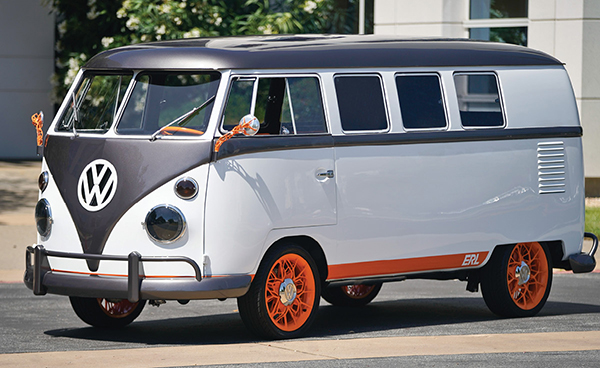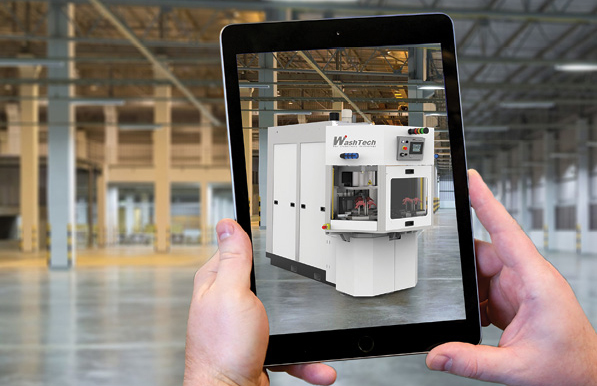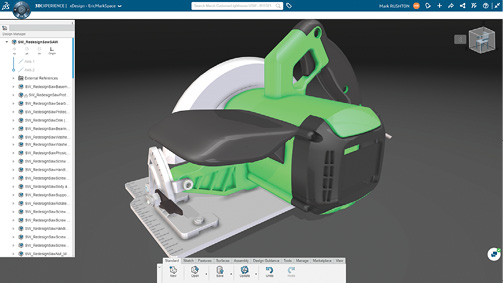
Autodesk recently collaborated with automaker Volkswagen, using generative design to give this iconic vehicle a more modern look. Image courtesy of Autodesk.
Latest News
September 1, 2019
Do you have a Snapchat account? Post regularly on Instagram? How about a YouTube subscription? If the answers are no, no, and no, and you fondly remember the oohs and aahs when the next-door neighbors brought home their first color TV, you might want to gulp down some Geritol before reading further. That’s because the next generation of designers is about to enter the workforce, and they have some different ideas about product design.
And Now, for This Commercial Break
“My teenaged kids don’t even understand TV commercials,” says Sam Sattel, senior marketing manager for Fusion 360 at Autodesk Inc. “They’re used to Netflix. They’re used to Hulu and Vudu. They want to watch what they want, when they want it, and for them, cable television is about as old-fashioned as using a mouse.”
Yes, you heard that right. A mouse. According to Sattel, Autodesk recently introduced a group of elementary school students to the company’s Tinkercad program, and every one of them ignored the traditional keyboard and mouse and reached for the computer screen, thinking it was a giant iPad.
Granted, today’s current design workforce hasn’t yet embraced this level of hands-on computer use, but rest assured, the upcoming touch-screen generation will demand it, just as they’ll demand social media integration, virtual reality tools, self-paced training, Google-like search capabilities and other advanced user interface (UI) capabilities.
The good news is that much of this sociotechnical wizardry is already here. Each of the companies interviewed rattled off a host of recent software enhancements, from augmented reality (AR) to artificial intelligence (AI), some of which have been around longer than today’s grade schoolers.
Many of these advancements are geared toward social media, also known as Web 2.0, or online participation. “The younger generation is all about sharing, from telling their friends what food they eat to showing them the clothes they wear,” Sattel says. “For those who’ve taken on a design role, they want to share their latest product models, their engineering data, their thought processes. Sharing’s part of the vernacular these days.”
Let’s Go Tubing
Dan Staples, vice president of mainstream engineering at Siemens PLM Software, explains that the social media generation wants to link with Facebook and software-specific communities, as well as post videos of their latest creations. “That’s a feature we introduced to Solid Edge a while back,” he says. “A user can record a screen session and upload it directly to YouTube. Not only does this give them a chance to show off their work, but it allows them to see how other people are approaching engineering challenges.”

Anyone concerned about intellectual property loss might raise their hand at this point, concerned that an overly eager designer may inadvertently give away the corporate farm, but Staples is quick to point out that this and other social media sharing functions are equipped with plenty of warning and safeguards, and are set to private mode by default.
While design software is becoming more social, it’s also getting smarter. AI is making it easier for young design engineers to get up to speed quickly, while at the same time making even experienced users more efficient. “For example, our NX product has the ability to identify user patterns and determine which functions are used more frequently,” says Staples. “Over time, it develops a command palette based on your interactions with the system.”
AI is the engine behind generative design in Fusion 360, adds Autodesk’s Sattel, a tool that changes the age-old question of “How do I solve the problems with this product design?” to “What are the problems I want to solve, and how can I design a product around them?” Virtual reality (VR) and AR also play a role in this space, tools that are helping designers young and old alike develop better products. “VR and AR, together with generative design technology, basically reverses software’s role—instead of a user driving the software, the software can now assist and in some ways drive the user,” he says.
Back to School
No matter how user-friendly the software, however, training is still required. Mark Rushton, SolidWorks’ product portfolio manager for Dassault Systèmes, suggests that Generation Z learns differently than their parents and grandparents. This helps explains why Dassault Systèmes and other software makers are offering far more online and self-paced training, rather than relying solely on the traditional classroom setting.

“We’ve offered video tutorials through my.solidworks.com for some time now, and have had pretty extensive training coverage on YouTube, not just from Dassault Systèmes and our value-added resellers but from the SolidWorks community in general, thanks in large part to the fact that a lot of our users like to share their content,” he says.
There’s also Gen Z’s love of mobile devices and app-based software to consider. Aside from their ability to watch training videos on their cellphones, Rushton points to Dassault Systèmes’ xDesign and xShape as ways to “design on the go,” as both are browser-based and designed with touch-screen devices in mind. “The younger generation in particular wants the ability to design on tablets, laptops and other touchscreen devices,” he says. “This is our way to support that desire.”
The Digital Transformation
The cloud helps. That’s because sharing, training and collaboration are made easier when software and its data is deployed from and stored in the cloud. On the 3DEXPERIENCE platform, says Rushton, users no longer need to send emails to one another, but can instead post an image or 3D model, or ask a question on a cloud-based 3DSwYm Community. “It’s just like any other social media feed,” he adds. “It even has a ‘Like’ button.”
There’s more driving this transformation than a socially-aware design community, though. As software becomes easier to operate, it’s becoming much more capable as well, an attribute that’s necessary to meet today’s complex design and engineering needs, says Marc Lind, senior vice president of strategy at Aras.
“Take the automotive industry, for instance,” he says. “A new car today is no longer simply an assembly of mechanical systems, but rather a rolling data center. You’ve got electronics and sensors and software throughout the vehicle—not just within the infotainment centers that everyone’s familiar with, but also the transmission, the engine, the steering and braking systems—everything within the vehicle is software enabled, which means that you need to coordinate that complexity across different disciplines.”
To do so requires a robust engineering platform, he adds, one with far greater flexibility than has been previously available. The UI must be streamlined and easy to use. It must support enterprise-level, context-sensitive search functions and graph visualization for simplified navigation across large data sets, giving users the ability to analyze information in “a more modern way than spreadsheets.”
“Everything is changing at a faster pace than ever before,” he says. “Sure, there’s a new group of users coming along with new requirements, but you also have additive manufacturing, the Internet of Things, AI and machine learning. On top of that, or perhaps because of it, there’s been a movement over the past decade where it’s suddenly cool to be in manufacturing again. It’s our job as software providers to support that movement as much as possible.”
More Aras Coverage
More Autodesk Coverage
More Dassault Systemes Coverage

More Siemens Digital Industries Software Coverage
Subscribe to our FREE magazine, FREE email newsletters or both!
Latest News
About the Author
Kip Hanson writes about all things manufacturing. You can reach him at .(JavaScript must be enabled to view this email address).
Follow DE







